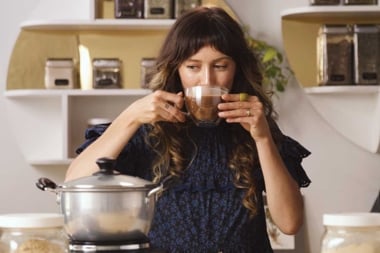
The lowdown on avoiding germs to help you prevent colds and flu.
The flu germs start to settle comfortably into the moist lining of your co-worker’s nose. Suddenly she sneezes. The germs fly out of her nostrils at 150 km per hour and land on the office water cooler.
Those germs will survive on the water cooler for up to 48 hours—long enough to jump ship when you get thirsty on your next coffee break. Infection seems inevitable. Or is it? Here are some ways to avoid giving those nasty stowaways a new home in your nasal cavity.
You can’t touch this
Cold and flu germs survive on nonporous surfaces such as plastic, metal, or wood for longer than they do on porous surfaces such as fabrics, skin, or paper. Of course, shaking hands or kissing people who are sickly is asking for trouble (unless you want to take a sick day together).
When you’re out in public, be especially aware of these bacterial hot spots:
- poles and door handles on public transportation such as buses and subways
- shared pens, computer keyboards, telephones, and wall switches—especially at work
- gas station pumps, ATM machine keypads, and shopping carts
- elevator buttons, escalator handrails, and doorknobs
- drinking fountains—especially ones that stay wet
Try to avoid contact with these potentially flu-ridden items by using a workaround, such as taking the stairs instead of the elevator, or using your own water bottle instead of the drinking fountain. Avoid contact with your hands by using your sleeves, wrists, or elbows. Carry around antiseptic wipes to sanitize a surface if you have to.
If you suspect you’ve been exposed, try not to touch your face. Use a hand sanitizer, or even better—wash your hands using the proper hand-washing technique, especially before you prepare food or eat.
At home, throw out your old sink sponge, which is a germ factory compared to dishcloths that you can wash regularly. Practise basic cleanliness, with special attention paid to kitchen and bathroom sinks, countertops, and floors. Germs love to snuggle up in dust, so break out the duster before you hole up inside for the winter.
Staying one step ahead
Unless you never leave your house, chances are you will be exposed to cold and flu germs at some point. However, if your immune system is in good shape, chances are your body will shrug it off without even a sniffle. Get enough sleep and incorporate plenty of antioxidants (vitamin E, A, C, and B-complex) and omega-3 fatty acids in your diet.
Some people find that echinacea strengthens their immune system as well. Don’t forget to exercise regularly through the cold winter months too.
If you do get sick, be courteous to others and sneeze into your elbow or a tissue. Take the day off work if you have to (see sidebar) but refrain from kissing your partner goodbye when he or she leaves for the day! And be thankful—your body will build up immunity to the virus so you can’t catch the same cold twice.
Proper hand-washing technique
Researchers have found that washing hands with soap and water for at least 20 seconds is enough to remove 90 percent of bacteria.
- Turn on the tap with a paper towel.
- Wet your hands and wrists with hot water.
- Use liquid soap.
- Work the soap into a lather and rub vigorously for about 20 seconds. Don’t forget to wash under rings, around cuticles, and under fingernails.
- Rinse your hands thoroughly.
- Turn off the tap with a towel or your sleeve.
- Dry your hands with a paper towel.
- Use paper towel to open restroom door.
Five reasons to avoid antibacterial soaps
The general consensus is that antibacterial soap is no better than regular soap, and in fact, can be harmful in the long run. Here are five reasons why.
- Colds and flus are viral infections, which are not stopped by antibacterial agents.
- Most antibacterial soaps produce a residue that stays on your hands and works slowly to kill bacteria. However, this prolonged exposure not only dries out your skin, but also kills the good bacteria.
- There is some evidence that triclosan, the main chemical used in most antibacterial soaps, is causing some bacteria to become stronger and more resistant to antibiotics.
- Antibacterial soap is making its way into our waste water and our streams. Increasing amounts of triclosan are being found in fish and even in human breast milk.
- Antibacterial soap gives people the false impression that they are protected and may cause them to lower their vigilance against cold and flu transmission.
Choosing the best hand sanitizer
Using a hand sanitizer should never replace proper hand washing but is useful if soap and water isn’t around. The most effective sanitizers use alcohol to kill bacteria. Acceptable alcohols include ethyl alcohol, ethanol, or isopropanol. Look for a sanitizer with an alcohol content of between 60 and 95 percent (anything less won’t be effective). Most sanitizers also contain moisturizers to reduce skin dryness. Always avoid products containing the chemicals triclosan or benzalkonium chloride
When to call in sick
So you wake up feeling decidedly wretched. Should you call in sick, or are you just having a bad morning? Consult the list below for some guidelines—but ultimately you need to make the call.
| GO TO WORK | CALL IN SICK |
|
|




